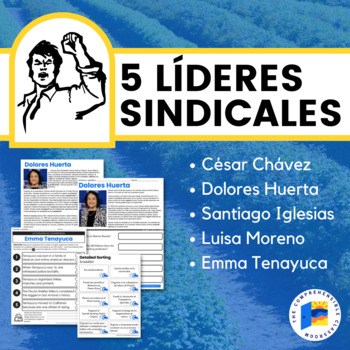5 líderes sindicales que debes conocer Labor Day resources in Spanish
- PDF
Description
Learn about five important Labor Leaders who influenced workers and working conditions in the United States and beyond. The core of this resource are 5 biographies, and each one is written at three different levels of text complexity. This resource is a great fit for Spanish 2-AP students to explore around Labor Day!
Líderes sindicales:
- César Chávez
- Dolores Huerta
- Emma Tenayuca
- Santiago Iglesias Pantín
- Luisa Moreno
Worksheets and small group activities included!
Each version of the biography is accompanied by one or two Comprehension/Processing activities, provided as full-page worksheets. The comprehension activity for the Simplified version is a half page activity below the text.
Two cumulative activities plus instructions are provided for students to review the information about all five Labor Leaders! These are perfect to use as a Jigsaw-Style activities in which each student in a group reads and works with information from a single leader, and they combine their knowledge with group mates to complete the cumulative activities.
About the texts:
SIMPLE: The Simple version is a half-page biography written with high frequency words and cognates. It may be understandable to students in their first semester of Spanish 2, especially if the class uses a communicative, Comprehension-based approach with a strong focus on extensive reading and listening.
DETAILED: The Detailed version is a full-page biography with many details and compound sentence structures. Although it relies heavily on high frequency words and cognates, it uses a broader vocabulary range than the Simplified version. It may be understandable to students in their second or third year of Spanish, depending on whether they have been in courses that have a strong focus on extensive reading and listening.
COMPLEX: The Complex version is a full-page biography with many details, a broad vocabulary range, and complex sentence structures. It may be understandable to students in their fourth through AP years of Spanish or for Native speakers of Spanish.
SUGGESTIONS FOR USE:
- The whole class reads the same version as part of a unit of study
- Differentiate by distributing different versions to different students
- Students work in pairs to read two versions and identify facts that appear in each
- Read all three versions in sequence, layered in with communicative activities such as discussion of the biographies or viewing and discussing audio-visual content related to the artist
- Teach the same lesson in multiple levels, modifying complexity
- Use for sub plans or too-sick-to-teach-days in multiple levels
- Add to class library and let students self-select which text is an appropriate challenge for themselves
- Laminate text on one side and comprehension activities on another and use as part of a Fast Finisher System
MORE RESOURCES LIKE THIS:





